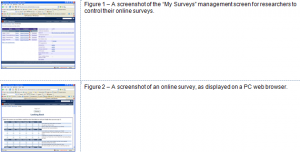Andrew Arnott and Dr. Joseph Olsen, FHSS Dean’s Office
Collecting research data on human subjects can be time consuming and costly. The Internet provides a new channel to survey people so that collected data is automatically added to a dataset without any possibility of human error by a data entry person. The Internet also allows a researcher to survey people who are geographically distant and on such a scale as would be extremely costly or impossible using paper and pencil.
Though not a researcher myself, I have worked with several researchers in the School of Family Life here at BYU and have become acutely aware of the need for researchers to take advantage of the Internet to collect their data using their limited budgets. Although there are several software packages available for purchase to help researchers in this way, each of them has limitations or high costs, leaving a need for some custom software to be written. And as it turned out, software that could be reused by many researchers on campus and off was the result.
EMAR is the software I wrote to fill this need. For ORCA, I proposed to extend EMAR to allow researchers to publish their own surveys online without intervention or help from me. I would write a web site for them to build their own surveys, collect and download data. I also proposed to make those online questionnaires available for responses through PDAs and cell phones in addition to the typical web browser on a PC.
Writing the web site for faculty to upload their questionnaires was well worth the effort, as several researchers have already begun using it. The most difficult part of building the web site was making it easy to use. Putting a questionnaire online is a complex and very flexible process, but offering those services and the vast array of options that researchers have in a way that does not overwhelm them, while minimizing training that they require, was very challenging.
I still find that each researcher who uses the site requires some assistance from me, and with each new researcher that uses the web site I learn new ways of enhancing and simplifying the web site so that it will be easier to use for the next researcher. At the time of this writing, one survey is actively collecting data for one researcher, and about fifty-five respondents have submitted their answers. As this site has grown, four other researchers have used this site to develop their surveys. EMAR has been used to collect 60,000+ surveys already, and I see this site as a terrific new front-end to extend the reach of EMAR to many more researchers.
I had the opportunity to present EMAR and its new web site front-end at an IASSIST conference in Edinburgh . This is a conference of data archivists and researchers. IASSIST permitted me a poster presentation, for which I had a 4’x5’ poster displaying how EMAR and this web site streamlines the research data collection process, and a laptop where I demoed the site live for those who approached the table. I was excited by the interest shown by everyone who stopped at my booth. Several people took notes and wanted to know how they could acquire this software.
Porting the online surveys to be taken on a PDA or cell phone instead of an ordinary PC web browser was another challenge. Both of these small devices are limited by small screens and limited web browser capabilities that require special survey presentation. I found that most Internet-enabled PDAs could display the questionnaire and allow a respondent to answer questions, but only the newer PDAs (roughly 2004 and newer) would display the questionnaire in an aesthetically pleasing way.
The Marriage & Family Therapy department asked for a PDA-enabled online survey called RDAS. I learned through this experience how to adjust a survey so that it would appear correctly for both a PDA and computer, and found that most of the work went into the survey itself rather than in adjusting the software. For example, each response option had to be offered in drop-downs rather than grids in order for the small screen to show all options available to the user at once. Because the MFT department already had PDAs, I used their hardware for testing. This operation has been a success, and their RDAS survey is now served online.
Only very recently have researchers shown interest in offering surveys over a cell phone. I think their could be a market for this, as many more people have cell phones than PDAs, and a cell phone would offer the survey whenever a person had a few minutes of free time. The idea would be to allow a person to answer a few questions now, and a few questions later, until the survey was finished. Because of the even smaller screen, and the probability that people will complete the survey across many different “sessions,” a great deal of work still needs to be done to make cell phone surveys ready for use.

